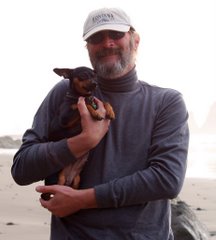Myheart beats true
For the red white and blue
Crazy for the blue, white and red
Crazy for the blue, white and red
And yellow fringe
Crazy for the blue, white, red and yellow
--Ragni, Rado and MacDermottTo hear The New Broadway Cast Recording version of Hair's "Don't Put It Down," click here.
People spend the Fourth of July in various ways. They eat hot dogs and potato salad, try to drown themselves in rivers and lakes, watch fireworks, or set themselves on fire, and, rarely, reflect on what it means to be an American. Very rarely, in my experience. I spent the day on top of a mountain. Specifically, I returned to the mountain where I spent Labor Day, 2008 and blogged about here.
Pat's Knob is the second highest peak in the Coeur d'Alène range of the Bitterroot Mountains, and is located just south of Plains. Standing on my deck, I can see Pat's Knob on the horizon. Because of its height, the mountain top is covered with various types of antennae and the buildings to house the radios behind those antennae. Kevin being a HAM operator, we go to the mountain to hear the voice of, well, probably not God. My Labor Day 2008 blog is all about the radio experience. This one won't repeat that.
As I noted on Tuesday, I'm working my way through Julia Cameron's The Sound of Paper. One of the activities Cameron suggests is a daily walk. Once a week your walk should be over an hour long. We arrived at the top of the mountain, and while Kevin and his HAM buddies were getting their equipment out, I took off down the mountain. That's right, I started at the top and walked down hill for half an hour. In the heat of the day. Wearing a t-shirt and shorts. (Note to Greg Johnson, if you're reading this: the t-shirt was black and had printed over the left breast the words "The Missoula Colony 3.") Of course the problem with hiking down hill at the start, is that when you're tired and whining, you have to turn around to hike back up the damn hill. But I was on a quest. This wasn't just a walk. This was a WALK, with the intent of communing with nature and spurring on any creativity left in me. I decided that a good project would be to find and photograph as much of the local flora as possible. In fact, my first title for today's blog was "Pat's Knob's Flora" and the music I wanted was from the Broadway musical, Flora the Red Menace, Kander and Ebb's first collaboration, the original production of which starred Liza Minella in a Tony winning performance. Unfortunately, there is no "Life is a Cabaret," or even "Mr. Cellophane" in Flora, and Youtube wasn't helpful.
Gardeners without green thumbs, e.g. myself, can get really frustrated on such hikes. Just as the forests above Smith River produce wild irises and azaleas that make my own look anemic, the wild raspberries growing with only God's help at 7,000 feet look oh so much healthier than the ones in my berry patch. Even the grass growing along the road is healthier than my own at home. Oh who am I kidding. There is no grass growing at home--except coming up as weeds between the raspberries.
But there were lots of things growing up on that mountain, the most impressive being the beargrass. Beargrass is always a show stopper, and the ones growing on Pat's Knob were no exception. While I saw other white flowers along the road, most notably Sego Lilies, pussytoes and Queen Anne's Lace (otherwise known as wild carrot), the Beargrass was by far the most notable--if only for its size.
Penstemon hirsutus or Hairy Beardtongue
And just as Ragni, Rado, and MacDermott, remind us, the American flag is usually red, white, blue, AND yellow, as in the yellow fringe that so often surrounds the flag on our school flag poles. I don't know what this particular flower is. There are so many different ones that all look alike, at least to the non-botanical eye, so I was happy to learn that Lady Bird Johnson, among others, just called them DYCs, or Damned Yellow Composites. I grew up calling them Daisies, then learned to call them Composites, and now I find that wildflower books call them Sunflowers or Asters. It's just too much to keep up with. I rather like DYC, myself.
Once back on top of the mountain, I pulled out my camp chair and my iPad. One of the things about being on a mountain with lots of antennae is that you get great reception. The iPad hooks up to any strong Verizon signal, and sure enough, on top of the Knob I was getting five bars. I spent the afternoon happily reading e-mail, catching up with Facebook, and other non-productive activities (AKA web surfing). The HAM guys, however were having troubles, and sure enough, we didn't get back down off the mountain until 6 pm. Still, I'm not complaining. I got my work done and am pretty happy with it. And in case you were wondering, this is what the world looked like from the top. It was a beautiful way to spend the Fourth.
Looking northwest toward Thompson Falls, Eddy Peak, and, eventually, Idaho.











